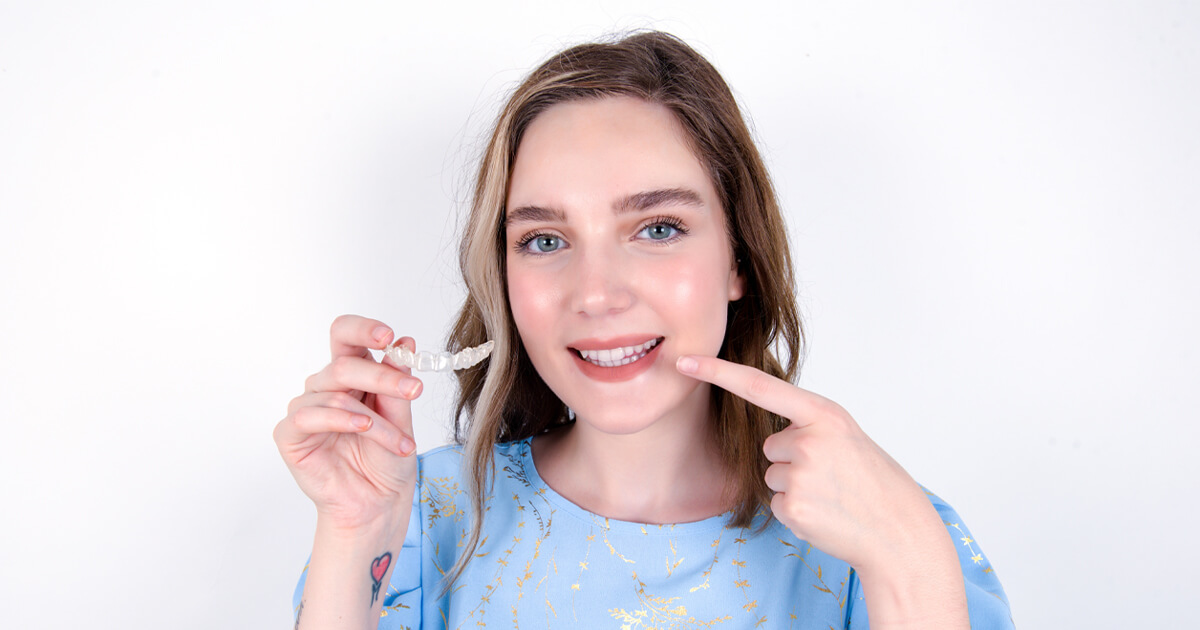How Do Clear Aligners Work? Straighten Your Teeth Discreetly

Clear aligners fit over your teeth to straighten them. They are a popular orthodontic treatment – particularly for adults – because they are virtually invisible. But how do clear aligners work, and are they for you?
What are clear aligners?
Treatment involves wearing a series of clear, removable aligners to gradually straighten the teeth. There are no brackets to glue to the teeth and no wires that require tightening. They are made from medical-grade plastic and simply worn over the teeth—like a mouthguard.
How do clear aligners work?
Clear aligners can be used to treat a wide variety of orthodontic problems. While traditional metal braces are still the most common type of orthodontic appliance, clear aligners are becoming increasingly popular.
Aligners are made of a clear, plastic material that is virtually invisible when worn and custom-made to fit your teeth. They are provided in batches, and each clear aligner is designed to be worn for about a week and then replaced with the next aligner in the series. Each clear aligner gradually moves the teeth a fraction into their desired final positions.
How long does treatment with clear aligners take?
Every case is different, but our dental professionals can give you a rough assessment of how long the treatment will take. Factors to consider are the degree of straightening required and how often you wear the aligners. On average, clear aligner treatment typically takes 12-18 months. However, straightening front buck teeth could take as little as three months.
How do clear aligners work with severely crooked teeth?
You will need to see a dentist for an assessment. However, clear aligners work best for people with mild to moderately crooked teeth. If your malocclusion is severe, traditional metal braces are likely to be your best option.
Are Clear Aligners Removable?
Yes, aligners are removable. However, for the treatment to be effective, they should be worn daily for 22 hours. Apart from when you are drinking water, each clear aligner will need to be removed when you are eating and drinking.
Following an excellent brushing and flossing routine is crucial to prevent the teeth and gums from accumulating plaque. Consequently, after you have eaten, you need to ensure debris is removed from your clear aligner. If you don’t, it can make the aligners uncomfortable or even damage them.
If you play sports, you may have to remove the aligners to prevent them from becoming damaged, particularly if you play contact sports.
What is the treatment process for clear aligners?
A consultation will confirm whether you are suitable for clear aligner treatment. A tailor-made treatment plan is established to remodel your smile, and the first batch of aligners is ordered. You must see the dentist every four to six weeks for a check-up to ensure the treatment is going as planned.
How easy are clear aligners to clean?
 Compared to fixed braces, aligners are very easy to clean. You can rinse them in cold or warm water but do not use hot water as this may warp the aligners. Alternatively, you can purchase a special cleaning solution for aligners. The aligner is soaked in the solution for 15 minutes to remove plaque. Otherwise, brushing with non-abrasive toothpaste will be fine.
Compared to fixed braces, aligners are very easy to clean. You can rinse them in cold or warm water but do not use hot water as this may warp the aligners. Alternatively, you can purchase a special cleaning solution for aligners. The aligner is soaked in the solution for 15 minutes to remove plaque. Otherwise, brushing with non-abrasive toothpaste will be fine.
As the aligners are made of clear plastic, they can become stained by some food and drinks – the usual culprits, such as red wine and curries! Smoking will also cause staining, so what better time to give up!
How do clear aligners work: The Bottom Line
Clear aligners are a great alternative to fixed metal braces. They are virtually invisible, comfortable to wear (no protruding wires or brackets to rub sensitive soft, mouth tissues) and are easy to keep clean and hygienic as you can remove them for cleaning. Why not schedule an appointment with our dentists for further information about our range of clear aligners, including ClearCorrect, SureSmile and Invisalign.
Note: Any surgical or invasive procedure carries risks. Before proceeding, you should seek a second opinion from an appropriately qualified health practitioner.
References
NHS: Overview Orthodontics
https://www.nhs.uk/conditions/orthodontics/
Colgate: What causes buck teeth?
https://www.colgate.com/en-us/oral-health/adult-orthodontics/buck-teeth-causes
